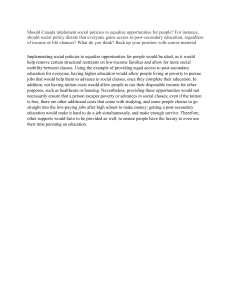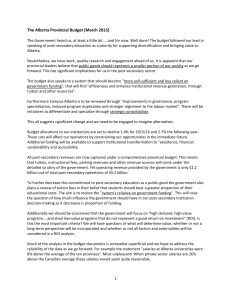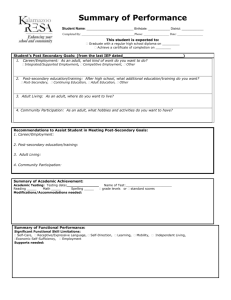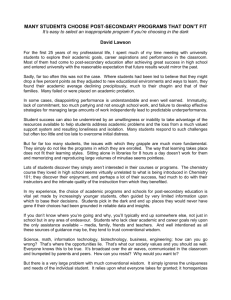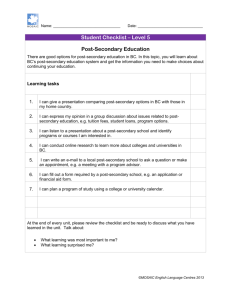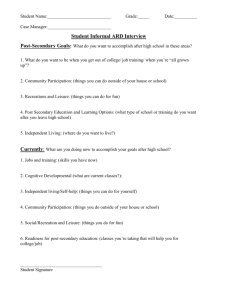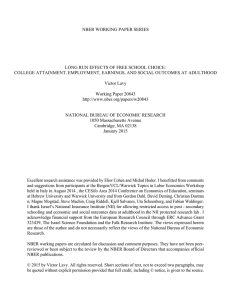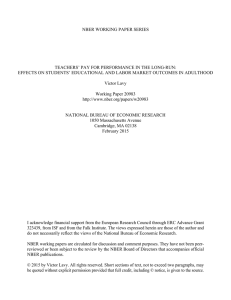Returns to Education: Investment & Funding Analysis
advertisement
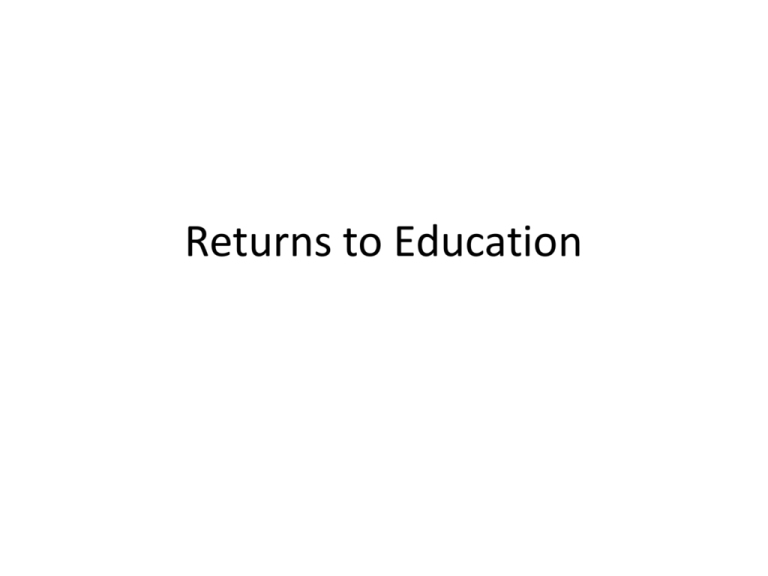
Returns to Education Background: Individual’s Perspective • Education is an important decision for many people – Higher levels of education can increase income streams – Higher educational attainment could also reduce the likelihood of unemployment – Higher levels of education are also associated with higher levels of health status Background: Government’s Perspective • Government’s also face a decision about whether it should allocate more resources to education as well as which part of the education sector (e.g., primary/elementary, secondary, post-secondary). Two Perspectives • Government – How to allocate scarce resources to education and within the education, which segment? • Individual – How to pick an education level to maximize lifetime earnings? • How would the government or individual make their decisions about education? – Can view these decisions as investment decisions, so pick a “project” that has the highest return. – Calculate the rate of return (internal rate of return) that makes the present value of net benefits of schooling zero • Recall that the IRR is computed as follows 𝐵1 − 𝐶1 𝐵𝑇 − 𝐶𝑇 𝐵0 − 𝐶0 + + ⋯+ =0 𝑇 1 + 𝐼𝑅𝑅 1 + 𝐼𝑅𝑅 – 𝐵0 , …,𝐵𝑇 are the benefits of education – 𝐶0 , …,𝐶𝑇 are the costs of education – For the government, if IRR > social discount rate then undertake investment in education; for an individual if IRR> interest rate undertake investment in education • Costs of Education: – Direct Costs: • Tution • Books – Indirect Costs • Lost wages • Benefits of Education: – Level of earnings associated with a particular level of schooling • Might also include health, but we’ll focus on earnings as a measure of benefits • Costs – Need to distinguish between the private and social cost • Private costs will not reflect the total costs for an individual because the government subsidizes education in Canada; the private share of costs of education does increase as level of education increases (e.g., university education requires tuition, but high school and elementary education does not) • For lower levels of educations, private costs are about 0, since government subsidizes education (e.g., no tuition or text book expenses) – Costs measure the resource costs required by the economy to produce a given level of education Examples of Costs of Education • Tuition fees are much lower in 1985-86 then they are today. • Textbooks were a lot cheaper then too. • Public costs exceed private costs • Public costs for graduate degrees are also highest Examples of Rates of Return to Education • Social rates of return tend to be about 3 percentage points smaller than the private rates of return. – This reflects differences in private and social costs of education – Suggests that individuals may overinvest in education because they don’t take into account the social costs Examples of Rates of Return: Public vs Private • Rates of return by level education. – Highest rates of return are for secondary (high school), which suggests policies that reduce dropouts (e.g., compulsory schooling) could be quite important. – Can have some negative rates of return; e.g. the Ph.D.; might get an overinvestment in PhDs, some students would be better off stopping with the master’s degree (would increase return to a PhD) • By major, can see highest rates of return tend to be for Commerce, Engineering and Health Degree (doctors and dentists); reflect higher wages that individuals earn in these fields. Reconsidering Earlier Estimates • The rates of return considered on the previous slides were based on earlier data, reaching into the 1980s. Unfortunately, this is not an active area of research so there rates of return based on more current data are not available. • One question is whether the estimates based on earlier data are still relevant for today? If they are not, would the estimates be smaller or larger than? Changes in Funding of Post-Secondary Education • In Canada, funding of the university and other post-secondary institutions is a provincial responsibility. • In many provinces the funding allocated to post-secondary education has declined in relative terms – Government funding for the healthcare sector has generally increased at a rate greater than GDP growth; Post-secondary education funding has in most provinces not kept pace with GDP growth. • For example, in 1990 about 80% of the University of Toronto’s operating budget was provided by the provincial government; today only 27% of the University’s budget is funded by the provincial government • Tuition represents a much larger share of the University’s revenues then in the past. • These changes have implications for rates of return to education. Analysis of Changes to Funding • Assume we hold everything else constant. • Since the government subsidy to post-secondary education has fallen, it would be likely that the difference between social and private rates of return to education have narrowed. • The social rate of return to education will be lower than the private rate of return, but the difference between the two should be narrower than observed in the estimates listed earlier in these slides. • But is everything really held constant? • Obviously, not; there have been changes in demands for certain skills; greater supply of university graduates; economic shocks (recessions); increases in tuition and other costs of education. • Without an analysis of more recent data we cannot say for sure what happened to rates of return to education; We can only hypothesize about the potential impacts.
